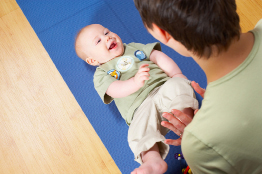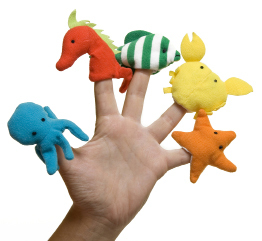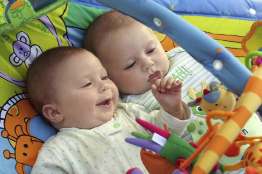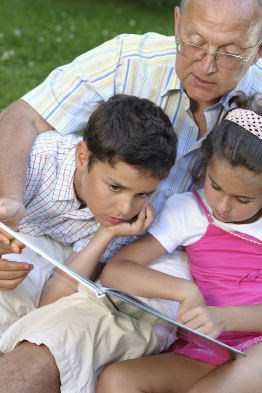Session 3
| Site: | MoodleHUB.ca 🍁 |
| Course: | CCS3120 |
| Book: | Session 3 |
| Printed by: | Guest user |
| Date: | Friday, 5 December 2025, 3:36 PM |
Description
Created by IMSreader
1. Session 3
Session 3: Language Development
Introduction

BananaStock/Thinkstock
Some toddlers speak very clearly. Other toddlers are difficult to understand. Is this normal?
Many of the three-year-olds in your child care say “I goned,” “We wented,” and “the fishes.” How should you respond?
You have just been offered a position in the infant room of the child care centre. How do you promote the language development of children that young?
Session 3 focuses on children’s language development in the first six years. You will learn how you, as a child care provider, can promote the language development of children in your care. Children’s language development involves their increasing ability to express themselves through words and sentences. Remarkable changes occur between the time of infant gurgling and a preschooler’s clear sentences.
Getting Focused Activity: What I Already Know About Language Development
Directions
Complete Getting Focused Activity: What I Already Know About Language Development.
Checking In
Save your completed learning activity in the appropriate sub-folder of your course folder.
1.1. Inquiry 1
Session 3: Language Development
Inquiry 1: Promoting Language Development
To provide you with an overview of the language development of children between the ages of birth to six years, watch the video “Language Development”
Connecting with Each Child

Brand X Pictures/Thinkstock
Children develop their language skills by doing the following:
- interacting with other children
- interacting with adults
- imitating sounds, words, and sentences
Children’s self-esteem plays an important role in the development of interaction and language skills.
Follow these strategies to connect with each child:
- Give respect and affection—doing so will help children feel more confident and be more willing to imitate what they see and hear.
- Take a moment to notice each child as an individual. All babies and children communicate. Pay attention to their facial expressions, body movements, what they are looking at, what they are reaching for, what they are playing with, and so on.
- Respond quickly. Be attentive and respond quickly to each child’s attempt to communicate with you.
- Observe and listen to each child. Watch, listen, and learn what each child finds interesting. Listen to the sounds and words the child uses.
- “Tune in” to each child. The way in which children interact with other children is important. For example, does a child only speak to one play partner at a time? Is the child able to take turns in talking with a playmate? If a child is unable to play, show the child how to play by being the child’s play partner. Gradually withdraw from the play when you see that the child is able to play with another partner.
- Have face-to-face contact. Children learn language best when they can see your face. Sometimes children need to watch your mouth to see the physical movements you make to produce a sound.
- Use appropriate physical contact. Close proximity and physical contact help the child focus attention on you and reinforce your relationship. Touching the child gently on the shoulder helps to maintain eye contact and makes the child feel secure.
- Use the child’s name before speaking. This helps to get the child’s attention.
- Imitate the child. This is perhaps the most important way to connect. It shows the child that you are listening and that you think what the child is saying or doing is important. In addition to repeating the child’s words, you can also add words. For example, if a toddler says, “ball,” you can say, “Yes. Ball. A big, big ball.”
- Play with each child. Children will more likely use their speech and language when they are having fun.
Adapted from content provided by Grant MacEwan University and Alberta Health Services.
Children’s Needs for Language Development
- Children need many opportunities to interact with adults during the day.
- Children need lots of opportunities to play with toys, children, and adults, in order to practise language skills.
- Children need time to play in groups, but also time for individual attention from an adult who can engage in conversation with the child.
- Children need toys, books, and props that promote conversations and experimentation with language (e.g., puppets, books, and dolls).
- Children need to have the opportunity to learn songs, finger plays, and poems that encourage language development.
- Children need time to think about what words they will use (wait five to ten seconds after asking a child a question).
- Children need adults to model appropriate social language.
vocabulary: the words a child understands and uses
Creating Environments for Language Play

Photos.com/Thinkstock
As expressed in the video, children learn language as they play. As infants, children experiment with sound as they shake toys and objects. Infants imitate actions, sounds, and gestures.
Toddlers add new words and names for the objects and people in their environment. Preschoolers experience a massive explosion of vocabulary and grammar. They begin to blend their active play with more symbolic expressions as they develop the “scripts” of their “play scenarios.” For example, children say, “Let’s pretend,” or “You be the mom and I’m the dad.”
The Role of the Caregiver
Follow these strategies to create an environment for language development:
- Be each child’s play partner—doing so lets the child know that what the child has to say is important, which encourages the child to speak more. Being a play partner provides opportunity for you to make observations and to determine where the child needs help.
- Encourage children to follow their own interests in play. Children learn language best when you talk about what they are focusing on. Use repetition.
- Observe each child and plan play that reflects what the child likes to do.
- Use words and sounds to match the interests and activities of a child. Toddlers like to experiment with simple sounds like “oooh,” “mmmmm,” or “crunch.” Notice the sounds around you and say the words (e.g., “listen to the wheels go s-q-u-e-a-k”) or make action noises (e.g., say “whoosh” when swinging).
- Encourage children to make choices—doing so encourages their senses of independence and self-confidence.
- Ask open-ended questions. Questions that don’t have a simple “yes” or “no” answer give children the opportunity to practise and play with language. The question, “What are you wearing today?” lets the child use lots of language to respond. “Are you wearing a new sweater today?” allows only a one-word answer: yes or no.
- Children need time to think about the words they will use. A good rule to follow is to wait five to ten seconds after asking a child a question. The child may need this much time to answer. Accept what the child says, and then add a response to have a two-way conversation.
- Provide age-appropriate play materials that give endless opportunities for creativity—“open-ended” materials, such as sand, water, blocks, books, and art materials, provide flexible opportunities for children to follow their interests and to move at their own paces. Introduce different words, concepts, and grammatical structures as the children explore and create.
- Provide props that encourage language play and literacy. Puppets and books can encourage language play and support literacy development. Picture books should be a part of the play centres throughout the playroom.
- Use songs, finger plays, and poems to support play at various centres. Add new songs by making up sentences that describe what the child is doing and by signing those words to a favourite tune. These kinds of songs make the children’s play more exciting and stretch the child’s language development. Use picture books to match singing with printed words. Read stories with lots of expression in your voice.
- Incorporate the languages spoken by all the children. Learning a few words in a new language can be done by asking the child’s parent, by using an Internet language program, or by asking a language teacher in your school. Include words both orally and visually. Incorporating a child’s first language supports the child’s learning and encourages a sense of belonging.

iStockphoto/Thinkstock
Review the Language Development video clips to see some of the strategies discussed above being used by child care providers. As you watch the videos this time, ask yourself the following questions:
- Do I understand the information better or differently than when I first watched the video?
- Have I observed any of the strategies presented being used with the children in the child care facility?
- How could I use the information presented to develop items and strategies that support language-rich environments for my strategies box?
Supporting Language Development
To support language development, be sure routines and boundaries are in place. For example, young children need at least 30-minute play sessions as this allows time for the language that goes with the play to develop and become more complex.
Adapted from content provided by Grant MacEwan University and Alberta Health Services.
A variety of play centres in which children can interact with various toys, concepts, ideas, and so on, is also important for children’s language development. Information on establishing routines and guidelines as well as on organizing the physical space within a child-centred facility was included in Session 4: Guiding Children’s Behaviour in CCS3110. Review your work from this session in your CCS3110 course folder. Consider carefully the information on the physical environment, routines, transitions and activities. In addition, review the child care provider’s interaction styles and methods for intervention and for setting clear guidelines. As you review all of this information, consider how your practices could either encourage and support or delay or prevent children’s language development.
Course Completion Checklist
Have you remembered to update your Course Completion Checklist? If you haven’t already started to use the checklist, access it in the Toolkit now. Remember to update the checklist every time you work on the course.
1.2. Learning Activity 1
Session 3: Language Development
Learning Activity 1: Promoting Language Development
Focus
Once you have an understanding of children’s language development, what the child needs in order for language skills to develop, and the role of the child care provider, you can reflect on your actions with children and plan the best possible ways of responding.
Directions
Step 1: With a partner from your class, review Key Concepts to Promoting Language Development.
Step 2: Still with your partner, complete Learning Activity 1: Promoting Language Development.
Important: Remember that working with a partner means responses should reflect both of your thinking. Just as when you work with children, it is important that you use excellent active listening skills when working with class peers.
Checking In
Both you and your partner will save a copy of your completed learning activity to the appropriate sub-folder of your individual course folders.
1.3. Inquiry 2
Session 3: Language Development
Inquiry 2: Developmental Milestones from Birth to Five Years
The Language Development table provides guidelines to illustrate how children progress through the stages of language development. It is important to remember that each child is unique and develops at his or her own rate.
Principles of Language Development

iStockphoto/Thinkstock
Consider the following principles of language development.
- All children are born with the ability to learn language.
| – As with other development areas, there are wide variations in the age at which children acquire language skills. |
- Children progress through predictable stages of language development.
| – The stages of language development are universal, regardless of which language the child is learning. Babies all over he world go through the same progression and utter the same sounds. |
- Language development is closely related to other developmental areas.
| – For example, when children reach the stage of intellectual development in which they can remember that a toy is put away in a cupboard, they will be able to use language to get the toy (e.g., Hafez points to the cupboard and says, “ball”). |
- Social language is used to express emotions or needs.
| – Children develop social language by imitating how adults and children interact with each other. |
- Children learn language as they play.
| – Children experiment with sounds as they shake toys when they are infants. Infants imitate sounds and gestures. Toddlers add new words and names for objects. Preschoolers experience a massive increase in their vocabulary and grammar, using imaginary situations (e.g., “Let’s pretend that . . .”) as well as real situations. Learning speech and language through play allows children to learn how to express their feelings and become more confident and secure. |
- Listening is a skill that children develop over time.
| – When children are in school, they are expected to listen in order to learn. Babies have difficulty listening to one voice when there are lots of noises around them. Children who, on a regular basis, do not seem to respond to noises, including voices, may have a hearing problem. It may be a good idea to have their hearing checked. |
- Respect the importance of preserving the child’s first language while providing assistance in English.
| – Many children in early childhood programs come from families in which English is not their first language. Language and culture give children a sense of pride in their identity, so it is important to preserve and respect diverse languages and cultures. |
- Children learn about language by interacting with adults.
| – Adults are the role models that children copy when producing sounds or using vocabulary and grammar. Adults provide information and questions. When children use incorrect language or inappropriate language (such as swearing), adults can gently model the correct language. This works best when children and adults have developed a positive relationship with each other and have fun together. |
Adapted from content provided by Grant MacEwan University and Alberta Health Services.
Checking My Understanding
Ideas on Language Development
Directions
In this Ideas on Language Development interactive activity, indicate whether each statement is true or false.
Encouraging Conversations
When children first learn to talk, they generally talk at others rather than with others. Being able to engage in conversation is an extremely important skill in the social world. With help, children learn and will accomplish the following:
- the ability to take turns when talking
- the ability to listen to what the other person is saying and then respond to that person
- increased vocabulary and grammar
Use the following strategies to support children’s learning by engaging them in conversation:
- Imitate the child to give the child the sense of an audience.
- Wait for the child to respond, and then accept what the child says. Next, provide another response so that your “conversation” is maintained.
- Look for ways to take turns during play and talking times. For example, with a toddler, roll a ball back and forth and say, “Your turn, my turn.”
- When a child says a word, repeat the word back to the child and add one or a few more words.
- Demonstrate what you mean with actions or in play. For example, rolling a ball back and forth lets the child explore the motion of taking turns.
- Expand conversations children have with you by asking simple questions or adding your thoughts or opinions in short phrases.
- Talk about things that interest the child.
- Avoid asking test questions—questions that make a child feel like she or he is being “put on the spot.” Test questions are not part of a true conversation.
- Avoid asking questions that require “yes” or “no” responses, as these questions do not demonstrate the give and take of conversation. Ask open-ended questions instead.
Adapted from content provided by Grant MacEwan University and Alberta Health Services.
test question: a question asked for which the answer is already known
Important: Remember that children will be listening and copying how you talk with other adults!
1.4. Learning Activity 2
Session 3: Language Development
Learning Activity 2: Incorporating Opportunities for Language Development into the Daily Schedule
Focus
Just as children’s language skills develop by watching and imitating adults and other children, so too can people becoming child care providers learn how to promote children’s language development by observing and imitating the practices of experienced child care providers.
Directions
Step 1: Open and print Learning Activity 2: Incorporating Opportunities for Language Development into the Daily Schedule.
Step 2: Go to the child care facility and observe children’s and child care providers’ interactions during the six activities listed in the table.
Step 3: Complete Learning Activity 2: Incorporating Opportunities for Language Development into the Daily Schedule.
Step 4: Review the Student Rubric for Learning Activity 2: Incorporating Opportunities for Language Development into the Daily Schedule. Assess the quality of your work and make any necessary adjustments.
Checking In
Save your completed learning activity and your self-assessment in the appropriate sub-folder of your course folder.
1.5. Inquiry 3
Session 3: Language Development
Inquiry 3: Supporting Literacy

iStockphoto/Thinkstock
Supporting Literacy
Children begin to learn about literacy (reading and writing) as infants. This early learning is very important so that children can develop the skills needed to read and write in school.
At first, babies will bang and chew on books and will enjoy spending time with you, flipping pages and talking about pictures. They are starting to learn what books are all about. As toddlers and preschoolers continue to interact with you and with books, they gradually learn how to hold a book and turn the pages, and they learn that pictures and words have meaning and represent real objects.
They learn that the squiggles and lines on the page are letters that create words that have meaning. They learn that English books are read from left to right. They also begin to understand a story has different parts; that stories have a beginning, middle, and an end; and that stories have characters, plot, and setting.
They learn that real people write and illustrate these books. Eventually they can retell the story, act it out, or recognize some of the printed words. They can memorize the repetitive parts and ‘read’ it to you, giving them confidence to learn more. These skills are all part of learning to read. Later they can make up their own stories.
Children learn about writing by watching you. They watch you write lists, order things from catalogues, write notes to parents, and put labels on pictures and objects. They learn that printing has many useful purposes.
Children begin to write with their first scribbles. These marks will turn into pictures, and squiggles will represent letters and words. Children will tell you stories based on these pictures. When you write down what they say about their pictures, they learn that printing has meaning and purpose. They learn that ‘writing’ is just talking ‘written down.’
Strategies to Support Literacy
Follow these strategies to support children as they learn to read and write.
- Read many, many stories to children. Reading on a daily basis demonstrates that you think reading and writing activities are important. It also provides the children with ‘scripts’ for their dramatic play as they learn about other people and new experiences. They learn that print has a purpose and meaning. They learn that stories have patterns and that sometimes you might be able to predict the ending or what will happen next. They learn new words and new ways of phrasing ideas.
- Read quality preschool picture books. For very young children, look for books that have clear pictures with few words. The amount of text can increase as children get older and are able to sit longer as you are reading to them. However, preschool picture books should not be chapter books. Look for books that play with the sounds of words, have rhymes, tell a good story that is interesting to children, and present real objects or situations. The language in the text should be descriptive.
- Song books: Use picture books that have songs. Sing the song together as you read the book.
- Pointing: Look for large books, and follow the text with your finger so children can see the direction in which we read. Point out printed words around the room, on packages, and in books. When reading, you can sometimes point to the words as you read them.
- Make sure you have time to read every day. It is important for children to have fun flipping pages, looking at pictures, pointing, talking about pictures, listening to stories, and making up their own stories for the pictures they see in books.
- Read good books over again, many times. Children like to look at and talk about the same book many times with you, alone or in a small group. They learn new words and concepts every time. Choose stories, finger plays, and songs that are short and simple, and that repeat phrases and words many times.
- Read fun books. Read books with animal sounds, nonsense words, rhymes, and words that start with the same sound. Books with songs the child already knows are also fun and support the child’s understanding of print.
- Labelling and printing: Surround children with printed words on the walls in the room. Label objects in the room using lowercase letters, which is the same print they will see in books. Display names of children in the room. Write and display stories about art work. Label and display photos taken during the day. Encourage the children to write. Provide the children with paper, pencils, pens, crayons, chalk, paint, and markers to encourage children to write and draw as they play.
- Create literacy play centres. For example, set up a writing centre or “office” for preschoolers with all kinds of paper and pencils to write with, envelopes, a computer or typewriter, a phone, and phone book. Display name cards with pictures of the children in the room so they can copy each other’s names onto envelopes or letters. Make a telephone book using the children’s names and numbers.
- Use literacy props in the play centres. Turn the house area into a store, and add food boxes that have print on them, pictures of food with labels underneath, newspaper flyers from grocery stores, and grocery lists. Make sure there are pencils and sheets of paper to enable the children to write lists of their own. Include a store sign, exit and entrance signs, and a rack with newspapers, magazines, books, a cookbooks. Make available play money to buy groceries with and add anything else that you and the children can think of!
Adapted from content provided by Grant MacEwan University and Alberta Health Services.
1.6. Learning Activity 3
Session 3: Language Development
Learning Activity 3: Wonderful Books for Children
Focus
Stories, finger plays, songs, and poems are so important for young children. Sharing information about appropriate books for children can help child care providers promote the language development of children.
Directions
Step 1: Find a book that you feel is appropriate for use with children in the child care facility. You may check the public library, your school library, the library at the child care centre, or your home.
Step 2: Complete Learning Activity 3: Wonderful Books for Children.
Step 3: Investigate diverse interactive methods that can be used to retell the story (e.g., finger play, clothesline story, flannel board, puppets, action song, and so on.) In your investigation, you might talk with other child care providers, search the Internet, read library books that focus on child development, speak with parents of young children, or ask young children.
Step 4: Choose a method for retelling the story. In your decision-making process, ask yourself the following questions:
- Do I have access to the necessary supplies, props, and so on?
- Is the method suitable to the story?
Step 5: Plan how you will retell the story in an interactive way to a small group of age-appropriate children. Remember, the purpose of your retelling should be to engage the children in developing their language skills.
Step 6: With a peer or friend, or a group of peers or friends, practise retelling the story using the method you chose. Using the Peer Rubric for Learning Activity 3: Wonderful Books for Children, have at least one peer or friend assess your performance. Make any necessary adjustments to your work. Practise as many times as you feel necessary.
Important: Your peer or friend may be, but does not need to be, a member of your CCS3120 course.
Step 7: In consultation with your teacher, determine how you will demonstrate your interactive retelling of the story. You might use one of the following methods to demonstrate your teaching to your teacher:
- Make a recording in a format that is acceptable to your teacher.
- Arrange a time and place to meet with your teacher.
- Retell the story while on a webcam with your teacher.
Step 8: Perform your interactive retelling of the story for your teacher.
Checking In
Save your completed learning activity and your peer assessment in the appropriate sub-folder of your course folder.
1.7. Session 3 Summary
Session 3: Language Development
Session Summary
Important: The quiz may contain questions beyond points highlighted in this summary. Be sure to review the session thoroughly.

iStockphoto/Thinkstock
Review Session 3 to prepare for writing the quiz. As you review, note the sections that connect with the following points:
- All children have a potential for learning.
- Children use their senses for learning.
- Language development is closely related to all other areas of development.
- Children go through a series of stages as they move toward adult thinking.
- The caregiver strongly influences the learning environment.
- Caregivers provide a stimulating environment that is safe both physically and emotionally. The environment includes a variety of materials that are appropriate to the children’s developmental levels.
- Caregivers model an excitement for discovering and learning.
- Caregivers ensure that the environment is culturally diverse and reflects the abilities of the children.
- Caregivers recognize that each child is an individual with varying abilities, learning styles, and interests.
Session Quiz
Checking In
Contact your teacher to decide together when and where you will complete the Session 3 Quiz.